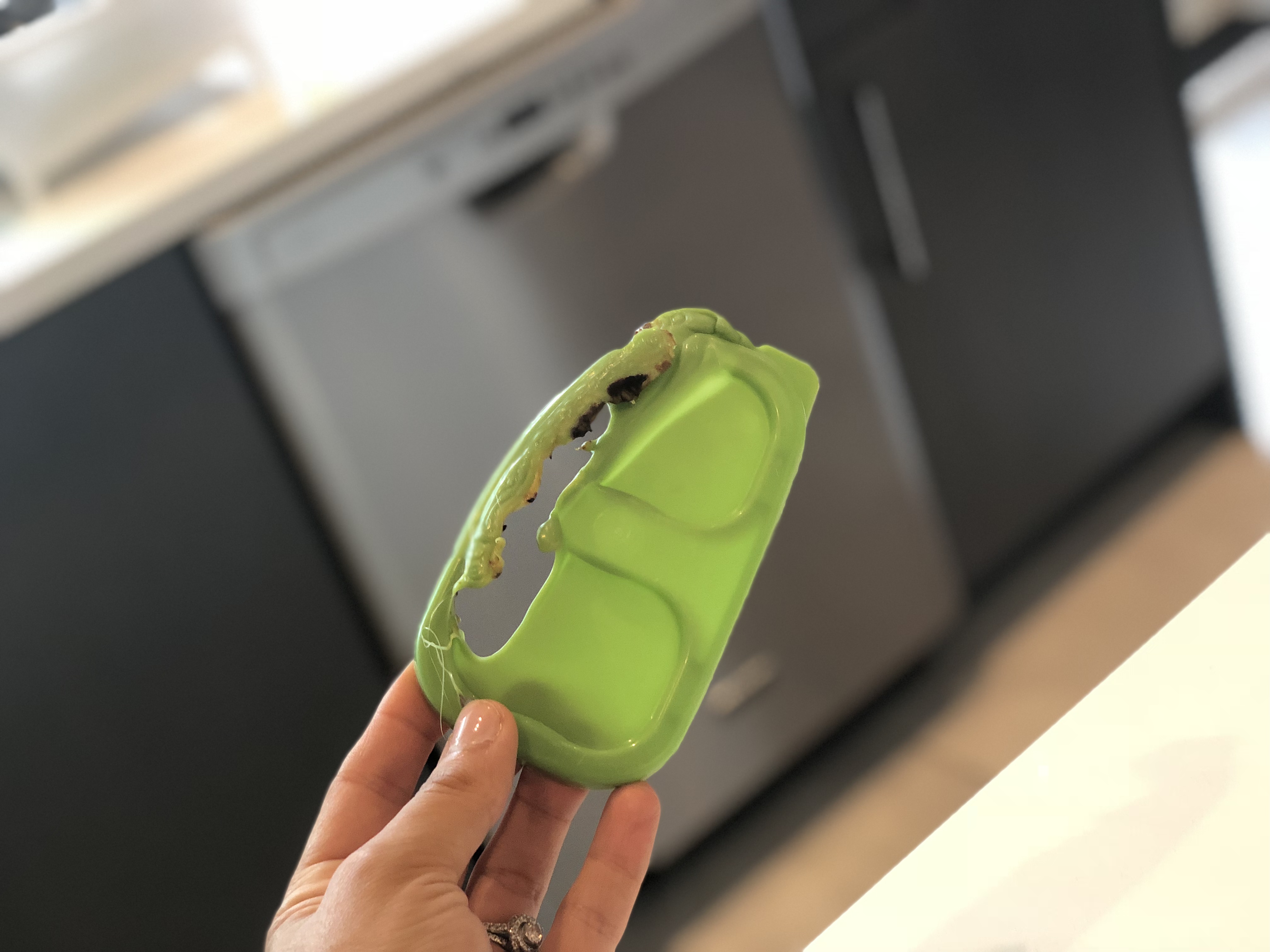Have you ever opened your dishwasher only to find a melted plastic mess inside? It’s frustrating, right?
That melted plastic smell, the sticky residue on your heating element, and the worry about whether your dishwasher is damaged can leave you feeling stuck. But don’t panic—understanding why your dishwasher melts plastic and how to fix it can save you time, money, and stress.
You’ll discover the common causes behind melting plastic in dishwashers, simple steps to safely remove it, and smart tips to prevent it from happening again. Keep reading to protect your dishwasher and keep your kitchen running smoothly.
Causes Of Plastic Melting
Plastic melting inside a dishwasher happens due to several common reasons. Understanding these causes helps prevent damage and keeps your dishwasher working well. Most plastic melts because it touches hot parts or is placed incorrectly. Other factors like overheating and exposed heating elements also play a role.
Plastic On Heating Element
Plastic items can slip from racks and land on the heating element. The element gets very hot during a cycle. Any plastic touching it will quickly melt. This usually happens with small items like lids or cutlery handles. Avoid placing plastic items near the bottom of the dishwasher.
Improper Placement
Placing plastic in the wrong spot causes melting. Some plastics are safe only on the top rack. The bottom rack is closer to the heating element and hotter. Putting plastic containers or utensils on the bottom rack risks melting. Always check dishwasher-safe labels and follow placement instructions.
Overheating Issues
Dishwashers have thermostats to control heat. A faulty thermostat may cause the heating element to stay on too long. This extra heat can melt plastic items. Overheating also wastes energy and can harm the dishwasher. Regular maintenance helps spot heating problems early.
Exposed Heating Coil
Some dishwashers have a visible heating coil at the bottom. This coil gets extremely hot. Plastic placed too close can melt from direct contact or radiant heat. Using the top rack for plastic helps avoid this risk. Some dishwashers have shielded coils to reduce melting chances.

Credit: www.onesmileymonkey.com
Risks Of Melting Plastic
Melting plastic inside a dishwasher poses serious risks. It harms your appliance and affects your home’s safety. Understanding these risks helps prevent damage and costly repairs. Below are key dangers linked to melting plastic in dishwashers.
Fire Hazards
Plastic melting can ignite fires inside the dishwasher. The heating element reaches very high temperatures. When plastic melts on or near it, flames can start. This risk increases if the dishwasher’s thermostat fails. Fire can spread quickly, causing property damage and injury.
Foul Odors
Melted plastic releases strong, unpleasant smells. These odors fill your kitchen and home. The smell comes from toxic fumes released during melting. It affects indoor air quality and can cause headaches or nausea. Proper ventilation and immediate cleaning are essential to reduce odors.
Damage To Dishwasher
Melted plastic can ruin the heating element and racks. It clogs drainage and blocks spray arms. This damage reduces dishwasher efficiency and lifespan. Repairing or replacing parts can be expensive. Avoid placing plastic too close to the heating element to protect your machine.
Removing Melted Plastic
Removing melted plastic from your dishwasher requires care and patience. The plastic can stick to the heating element or other parts, making removal tricky. Start by ensuring your safety and then cool the dishwasher completely. Use the right tools to avoid damage. Finally, clean away any residue and odors to keep your dishwasher fresh and working well.
Safety Precautions
Always unplug the dishwasher before starting. Turn off the power at the circuit breaker. Avoid touching the heating element until it is cool. Wear gloves to protect your hands from sharp edges. Keep children and pets away during cleaning.
Cooling The Dishwasher
Let the dishwasher sit for several hours after use. This stops burns or damage to parts. Do not try to remove plastic while the element is hot. Use a fan or open windows to help cool the area faster. Check that the heating element feels cool before touching.
Using Non-metallic Tools
Use wooden or plastic spatulas to scrape off melted plastic. Avoid metal tools that can scratch or damage the heating element. Gently lift the plastic without forcing it. If needed, soften the plastic by running a warm water rinse cycle first. Take your time to prevent further damage.
Cleaning Residue And Odors
After removing plastic, clean the area with a mild detergent and warm water. Use a soft cloth or sponge to wipe away residue. Run an empty dishwasher cycle with a dishwasher cleaner or vinegar. This removes lingering smells and burns off small bits of plastic. Repeat if odors persist.
Preventing Future Melting
Preventing plastic from melting in your dishwasher helps save your dishes and appliance. Knowing how to place plastics, choose the right items, and set the dryer can stop damage. These simple steps reduce the risk of plastic touching hot parts or overheating. Protect your dishwasher and plastics by following clear guidelines.
Proper Plastic Placement
Always place plastic items on the top rack. The bottom rack is closer to the heating element. Plastic on the bottom can melt from direct heat. Make sure no plastic hangs over the rack edges. Keep small plastic pieces secure to avoid falling onto the heating element.
Choosing Dishwasher-safe Items
Check each plastic item for a dishwasher-safe label. Not all plastics can handle dishwasher heat. Avoid washing thin or cheap plastic containers in the dishwasher. Use plastics made for dishwasher use only. This prevents warping, melting, and damage to the dishwasher.
Adjusting Drying Settings
Turn off the heated dry option when possible. Heated drying raises the temperature inside the dishwasher. This can soften or melt plastics. Use air-dry or towel dry instead. Lower heat helps keep plastics safe and extends their life.
When To Seek Professional Help
Knowing when to seek professional help for a dishwasher melting plastic problem is crucial. Some issues need expert attention to avoid damage or safety risks. Acting quickly can prevent costly repairs and ensure your appliance works properly.
Persistent Burning Smell
A burning smell that does not go away after cleaning signals a serious problem. It may mean melted plastic is stuck deep inside or electrical parts are overheating. A professional can inspect and fix hidden damage safely.
Faulty Thermostat Or Controls
The thermostat controls the dishwasher’s temperature. If it malfunctions, the heating element may get too hot and melt plastics. Faulty controls can cause repeated overheating. A technician can test and replace these parts to stop the issue.
Incomplete Plastic Removal
Removing melted plastic yourself can be tricky. Some plastic may remain on the heating element or in hard-to-reach areas. Professionals have the right tools and skills to clean thoroughly. They ensure no residue causes future melting or odors.

Credit: www.reddit.com

Credit: www.reddit.com
Frequently Asked Questions
Why Is My Dishwasher Melting Plastic?
Your dishwasher melts plastic because items touch the exposed heating element or it overheats. Place plastics on the top rack and use dishwasher-safe items only. Check for a faulty thermostat if melting persists. Always unplug before cleaning melted plastic carefully from the heating element.
Will Dishwasher Heat Dry Melt Plastic?
Dishwasher heat dry can melt plastic if items touch the exposed heating element. Always place plastics on the top rack. Use dishwasher-safe plastics and avoid heated dry cycles to prevent melting.
What To Do After Melting Plastic In The Dishwasher?
Unplug the dishwasher and let it cool completely. Gently scrape off melted plastic using a wooden or plastic tool. Place plastics only on the top rack and avoid heated dry cycles. Run an empty cleaning cycle to remove residue and odor.
Call a professional if melting or burning continues.
What To Do If Plastic Melted In Dishwasher Reddit?
Unplug the dishwasher and let it cool. Gently scrape melted plastic off the heating element using a wooden tool. Place plastics only on the top rack and avoid heated dry cycles. Run an empty cleaning cycle to remove residue. Call a professional if melting or odors persist.
Why Does My Dishwasher Melt Plastic Items?
Plastic melts when placed too close to the dishwasher’s heating element, which gets very hot during cycles.
Conclusion
Melted plastic in your dishwasher can cause damage and odors. Act quickly to unplug and cool the machine before cleaning. Use gentle tools to remove plastic safely without harming the heating element. Always place plastic items on the top rack and check they are dishwasher-safe.
Running a cleaning cycle helps remove leftover smells. Call a professional if problems continue or if you suspect electrical faults. Taking these steps keeps your dishwasher working well and prevents plastic melting in the future. Simple care makes a big difference.
